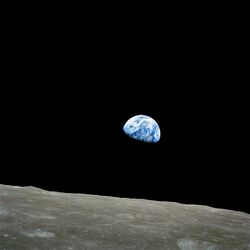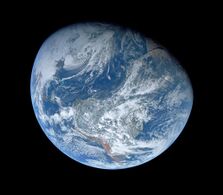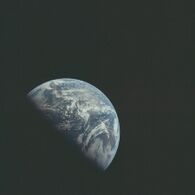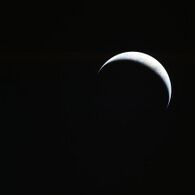Astronomy:Earth phase
 Earthrise by Apollo 8 astronaut William Anders, December 1968. Earth at gibbous phase as seen from the Moon. | |
The Earth phase, Terra phase, terrestrial phase, or phase of Earth, is the shape of the directly sunlit portion of Earth as viewed from the Moon (or elsewhere extraterrestrially). From the Moon, the Earth phases gradually and cyclically change over the period of a synodic month (about 29.53 days), as the orbital positions of the Moon around Earth and of Earth around the Sun shift.[1][2][3][4][5][6]
Overview
Among the most prominent features of the Moon's sky is Earth. Earth's angular diameter (1.9°) is four times the Moon's as seen from Earth, although because the Moon's orbit is eccentric, Earth's apparent size in the sky varies by about 5% either way (ranging between 1.8° and 2.0° in diameter). Earth shows phases, just like the Moon does for terrestrial observers. The phases, however, are opposite; when the terrestrial observer sees the full Moon, the lunar observer sees a "new Earth", and vice versa. Earth's albedo is three times as high as that of the Moon (due in part to its whitish cloud cover), and coupled with the wider area, the full Earth glows over 50 times brighter than the full Moon at zenith does for the terrestrial observer. This Earth light reflected on the Moon's un-sunlit half is bright enough to be visible from Earth, even to the unaided eye – a phenomenon known as earthshine.
As a result of the Moon's synchronous rotation, one side of the Moon (the "near side") is permanently turned towards Earth, and the other side, the "far side", mostly cannot be seen from Earth. This means, conversely, that Earth can be seen only from the near side of the Moon and would always be invisible from the far side. The Earth is seen from the lunar surface to rotate, with a period of approximately one Earth day (differing slightly due to the Moon's orbital motion).
If the Moon's rotation were purely synchronous, Earth would not have any noticeable movement in the Moon's sky. However, due to the Moon's libration, Earth does perform a slow and complex wobbling movement. Once a month, as seen from the Moon, Earth traces out an approximate oval 18° in diameter. The exact shape and orientation of this oval depend on one's location on the Moon. As a result, near the boundary of the near and far sides of the Moon, Earth is sometimes below the horizon and sometimes above it.
To be aware, although genuine photographs of the Earth viewed from the Moon exist, many from NASA, some photographs shared on social media, that are purported to be the Earth viewed from the Moon, may not be real.[7]
Phases of the Earth
- Earth phases
See also
- Earthrise
- Extraterrestrial sky
- List of first images of Earth from space
- List of notable images of Earth from space
- Lunar phase
- Overview effect
- Pale Blue Dot
- Pale Orange Dot (Early Earth)
- Planetary phase
- The Blue Marble
- The Day the Earth Smiled
References
- ↑ Gannon, Megan (30 June 2019). "If You're On the Moon, Does the Earth Appear to Go Through Phases?". Live Science. https://www.livescience.com/65831-earth-phases-from-moon.html. Retrieved 30 June 2019.
- ↑ Staff (13 March 2013). "The Phases of Earth". Futurism.com. https://futurism.com/the-phases-of-earth. Retrieved 30 June 2019.
- ↑ Staff (21 June 2008). "Changing Earth phases, seen from the moon". Earth & Sky. https://earthsky.org/space/what-would-earth-look-like-from-the-moon. Retrieved 30 June 2019.
- ↑ King, Bob (17 October 2018). "Observing Earth from the Moon". Sky & Telescope. https://www.skyandtelescope.com/astronomy-blogs/explore-night-bob-king/observing-earth-from-the-moon/. Retrieved 30 June 2019.
- ↑ Staff (15 July 1999). "If you are on the moon, does the Earth have phases similar to moon phases? Would they be the same or reversed?". University of California, Santa Barbara. http://scienceline.ucsb.edu/getkey.php?key=3133. Retrieved 1 July 2019.
- ↑ Cain, Fraser (13 October 2014). "What Does Earth Look Like From the Moon?". Universe Today. https://www.universetoday.com/115235/what-does-earth-look-like-from-the-moon/. Retrieved 1 July 2019.
- ↑ Evon, Dan (15 July 2019). "Is This a Real Photo of the Earth from the Moon? - Genuine photographs showing the Earth from the moon exist, many from NASA.". Snopes. https://www.snopes.com/fact-check/image-of-earth-from-moon/. Retrieved 17 July 2019.
External links
 |










